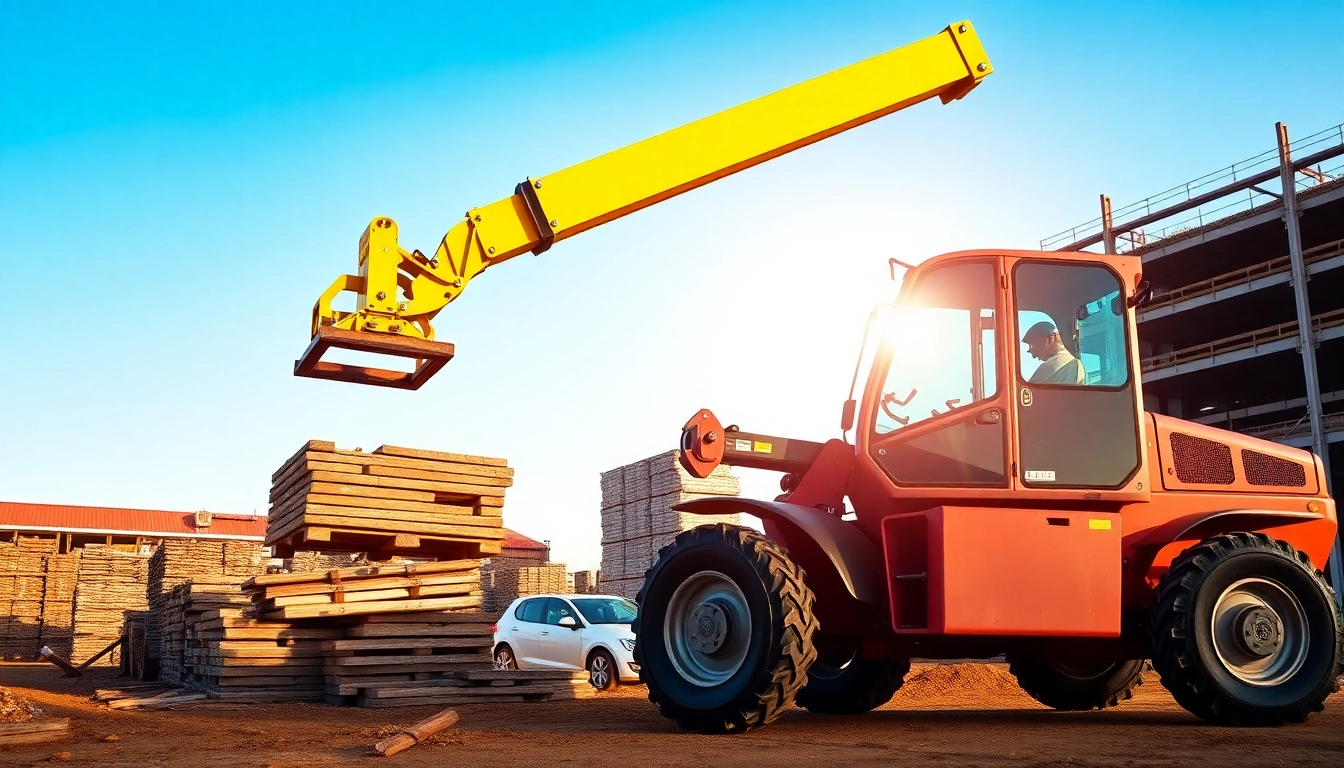Understanding Telehandler Rental: Key Features and Benefits
In the dynamic landscape of construction, agriculture, and industrial projects, the need for versatile, reliable lifting equipment is paramount. Among the most indispensable tools is the telehandler, a machine renowned for its flexibility and efficiency. As projects become increasingly complex and budget-conscious, telehandler rental offers a cost-effective solution that combines operational flexibility with operational safety. This comprehensive guide explores everything you need to know about telehandler rental, from core features to strategic benefits, ensuring your project leverages these machines effectively and safely.
What is a Telehandler?
A telehandler, officially known as a telescopic handler, is a versatile lifting machine featuring a telescopic boom that extends forwards and upwards. Often mistaken for traditional forklifts, telehandlers are specifically designed to handle heavier loads, reach greater heights, and operate in challenging environments. They combine the stability and lifting capacity of a crane with the maneuverability of a forklift, making them an essential asset across various sectors such as construction, agriculture, manufacturing, and logistics.
Typical components include an adjustable boom, which can extend to various lengths, and attachments like forks, buckets, or lifting hooks. This adaptability permits telehandlers to perform multiple functions—lifting, placing, and transporting materials—making them a one-machine solution for many operational needs.
For many companies, the decision to explore telehandler rental is driven by the necessity for flexibility, technological advancements, and the high costs associated with purchasing and maintaining such equipment. By choosing rental options, companies gain access to the latest models and technological features without the long-term commitments.
Advantages of Renting versus Buying
Financial Flexibility and Cost Savings
One of the most compelling reasons to opt for telehandler rental is significant cost savings. Purchasing new telehandlers entails large capital expenditure, ongoing maintenance costs, storage concerns, and depreciation. Rental solutions allow businesses to convert capital costs into manageable operational expenses, freeing up financial resources.
Access to Latest Technology and Models
The telehandler market evolves rapidly with new safety features, higher capacities, and improved fuel efficiency. Renting provides access to the latest models equipped with advanced features such as joystick controls, intuitive displays, and increased safety systems—without the commitment of ownership. This ensures enhanced productivity and safety standards.
Maintenance and Support
Renting companies typically include maintenance and support within their packages, reducing downtime and operational headaches for your team. Regular inspections, servicing, and repairs are managed by the rental provider, allowing your workforce to focus on core tasks.
Operational Flexibility
Rental agreements are often project-specific, allowing you to scale equipment up or down based on project size and scope. This flexibility minimizes idle equipment costs and enables quick adaptation to changing project demands.
Risk Mitigation
Rental reduces the risks associated with equipment obsolescence, market fluctuations, and unforeseen repair costs. Additionally, rental companies often handle compliance with safety standards, ensuring your equipment meets all regulatory requirements.
Common Applications in Construction and Industry
Construction Projects
Construction sites require lifting and placing heavy loads at various heights. Telehandlers facilitate the movement of building materials, scaffolding, and equipment across rough terrain. They are invaluable for tasks like placing concrete blocks, lifting steel beams, and installing cladding or roofing structures.
Agricultural Operations
In agriculture, telehandlers are used for stacking hay bales, moving feed, and loading/unloading farming machinery. Their ability to operate on uneven fields and handle diverse attachments makes them ideal for farm management.
Industrial Warehousing and Logistics
Within warehouses and distribution centers, telehandlers assist in stacking pallets, loading trucks, and managing inventory across varying shelf heights. Their reach and load capacity streamline material handling processes efficiently.
Infrastructure and Event Setup
From setting up large-scale events to infrastructure projects such as bridge installation, telehandlers enable quick, safe, and precise placement of heavy components in challenging conditions.
This diverse applicability underscores the importance of selecting the right telehandler for your specific industry needs, which we will address in the next section.
Choosing the Right Telehandler for Your Project
Types of Telehandlers Available
The market offers a variety of telehandlers tailored for different applications:
- Compact Telehandlers: Ideal for confined spaces, these models typically have lifting heights up to 4-6 meters and are perfect for small to medium projects or indoor operations.
- Standard Telehandlers: Offering lift heights between 7-15 meters, these machines balance maneuverability with reach and load capacity, suitable for diverse tasks.
- Heavy-duty Telehandlers: Designed for demanding applications, these models extend up to 30 meters or more, with high load capacities, suitable for large-scale industrial or infrastructural projects.
Size, Height, and Load Capacity Considerations
Understanding your project’s specific requirements is crucial in selecting a telehandler. Key factors include:
- Maximum Lift Height: Determine the highest point you need to reach. For example, placing ceiling supports or second-story materials requires model specifications up to the necessary height.
- Load Capacity: Assess the maximum weight of materials or equipment you’ll handle. Overloading can jeopardize safety and machinery lifespan.
- Working Environment: Indoor or outdoor? Rough terrain or paved surfaces? The environment influences the choice of tires, stability requirements, and size.
Factors to Consider When Renting
Before finalizing your rental, evaluate these considerations:
- Duration of Rental: Longer rentals often lead to better rates. Clarify terms to avoid hidden charges.
- Site Conditions: Ensure the telehandler’s specifications match terrain and space constraints.
- Attachments Needed: Decide if additional attachments like buckets or extensions are required, and confirm their compatibility.
- Operator Expertise: Verify if you need an operator included or if your team will operate the machine post-training.
Best Practices for Safe and Efficient Telehandler Usage
Operator Training and Certification
Operating a telehandler safely requires proper training. Certified operators understand load limits, stability principles, and safety protocols. Many rental providers offer or recommend accredited training programs ensuring compliance with UK health and safety regulations.
Employing trained operators significantly reduces incidents, damage, and operational downtime.
Maintenance and Inspection Tips
Regular pre-operation inspections are vital. Key points include:
- Checking hydraulic fluid levels and leaks
- Inspecting tires for damage or excessive wear
- Ensuring safety devices like brakes, lights, and alarms are functional
- Verifying attachment integrity and secure connections
Follow the manufacturer’s maintenance schedule rigorously to maximize lifespan and safety.
Compliance with Safety Regulations
Adherence to UK safety standards, such as those set by the Health and Safety Executive (HSE), is essential. Regular risk assessments, proper signage, and ensuring operators have relevant certifications are critical steps. Additionally, maintenance logs should be kept up-to-date to demonstrate adherence during inspections.
Cost Factors and Budgeting for Telehandler Rental
Rental Price Range and What’s Included
Rental prices vary based on size, capacity, and rental duration. Typical daily rates range from £100 to £300, with weekly rentals costing between £400 and £1,500. Many providers include basic insurance, maintenance, and emergency support within this rate, simplifying budgeting.
Additional Fees and Charges to Watch For
Be aware of potential extra costs, including:
- Delivery and collection charges
- Extended operation or overtime fees
- Attachments or specialised equipment rental
- Insurance premiums beyond basic coverage
- Training or operator licensing if required
Cost Comparison with Alternative Lifting Equipment
Compared to cranes or forklifts, telehandlers often provide a more versatile and cost-effective solution for medium to large projects, especially when extended reach or terrain mobility is needed. Their multi-functionality can reduce the need for multiple pieces of equipment, leading to overall cost savings.
How to Secure the Best Telehandler Rental Deals in the UK
Top Rental Providers and Their Offerings
The UK boasts numerous reputable telehandler rental companies, each offering a variety of models and services. Leading providers include Sunbelt Rentals, Speedy Hire, Brandon Hire Station, and regional specialists. These companies often feature nationwide coverage, quick delivery options, and flexible rental terms.
Tips for Negotiating Rental Contracts
To maximize value:
- Compare quotes from multiple providers
- Negotiate for extended rental discounts or bundled services
- Clarify all terms, including damage waiver and liability clauses
- Request detailed breakdowns of costs upfront
- Leverage references or long-term rental agreements for better rates
Leveraging Bulk and Long-term Rental Discounts
If your project demands multiple units or extended periods, discuss bulk rental options. Many providers favor long-term contracts, providing preferential rates and priority support. Planning ahead and establishing strong relationships with rental companies can unlock substantial savings and guaranteed availability.





